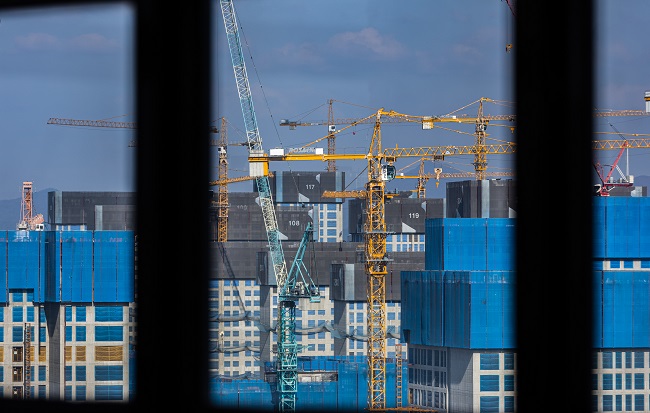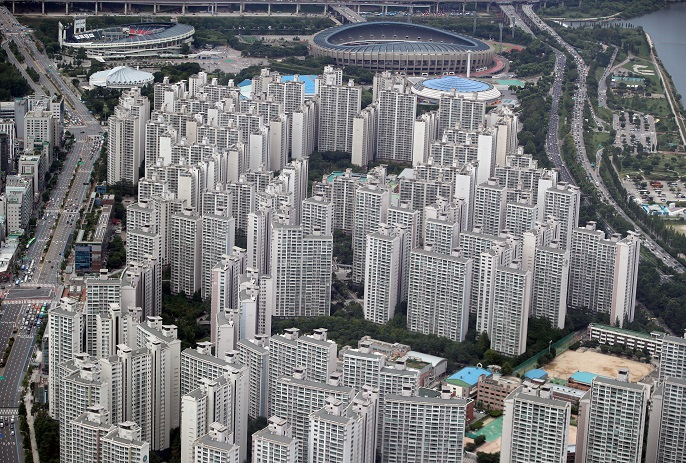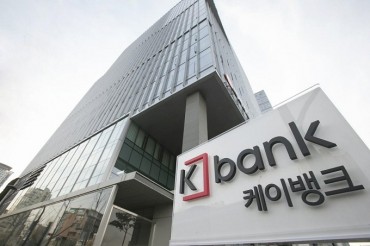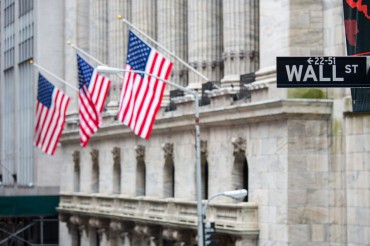
This photo taken on Oct. 24, 2022, shows a construction site of an apartment complex in east of Seoul. (Yonhap)
SEOUL, Jan. 4 (Korea Bizwire) — Home prices in South Korea are cooling at a jaw-dropping clip amid soaring borrowing costs and an economic slowdown, portending that indebted home owners may face the toughest-ever challenge this year and Asia’s fourth-largest economy may suffer a decline in private spending.
The country’s apartment prices nationwide fell 0.76 percent during the last week of December from a week ago, the steepest weekly fall since May 2012, when related data began to be compiled, according to the Korea Real Estate Board, as sharply spiking borrowing costs sapped demand for homes.
“As demand (for homes) sharply decreased, potential buyers remain hesitant in buying homes. More and more people expect home prices to fall further down the road,” said the Korea Real Estate Board, which is affiliated with the Ministry of Land, Infrastructure and Transport.
Prices of “jeonse,” a decadeslong leasing scheme here and one of the key barometers for housing prices, fell 1.13 percent during the cited period, also the sharpest decline on a weekly basis, according to the data.
Under the jeonse system, tenants transfer a large lump-sum deposit, known as key money, to the landlord, which is then returned at the end of the rental agreement, which usually lasts two years.
During the lease period, the tenants do not pay monthly rent.

This file photo taken Oct. 27, 2022, shows a notice about mortgage loans at a bank in Seoul. (Yonhap)
After boiling up fast in the wake of the COVID-19 pandemic, driven by economy-boosting measures and easy money, home prices dropped at the fastest pace on record as the Bank of Korea (BOK)’s abrupt about-face in its monetary policy has worked to cut the value of property.
The BOK has hiked its benchmark policy rate by a combined 2.75 percentage points since August 2021 to the current 3.25 percent to bring inflation down.
The hawkish monetary stance has been in line with aggressive U.S. rate increases aimed at combating skyrocketing inflation.
South Korea’s consumer prices, a major gauge of inflation, jumped 5.1 percent on-year in 2022, the fastest on-year rise since 1998, when the country was in the midst of the Asian financial crisis.
The South Korean government has started cutting taxes and easing loan regulations to help buttress up the troubled home market, but things do not bode well.
As its latest lifeline for the home market, the government has decided to remove Seoul and its adjacent metropolitan areas from the closely-watched speculative districts except for four districts — Gangnam, Seocho and Songpa in southern Seoul and Yongsan in central Seoul.
“The measures may help the home market make a soft landing, but it is uncertain whether a rebound in the home market will come given an economic slump,” Park Won-gap, a real estate analyst at KB Bank, said.
Many expect home prices to slide further as a set of unfavorable factors are intertwined, leading to a vicious cycle.
BOK Gov. Rhee Chang-yong earlier this week underlined the need for the central bank to place a focus on price stability in carrying out its monetary policy this year, indicating a further rate hike is in store should inflation remain high.
“As inflation, which is most important to people’s livelihoods, is expected to stay over the midterm target range, we will continue our monetary policy this year with a focus placed on price stability,” Rhee said in his New Year’s message.
The country’s central bank may raise its policy rate to at least 3.5 percent, according to market watchers.
Rising market rates may exacerbate the country’s already troubled home market.
For one, the average mortgage rate stood at some 2.7 percent in the first quarter of 2022, but the rate jumped to around 5 percent in November, according to the central bank’s data.
For indebted home owners, a rising market rate means a bigger interest repayment as most property loans here are tied to benchmark rates.
In the end, those who jumped on the bandwagon to buy homes with heavy debt out of fear of missing out will be forced to sell their home at cheaper prices than they have bought.
The rising market rates also prod potential buyers to delay or reconsider their buying.

The file photo shows an aerial view of a large apartment complex in Seoul’s southeastern Songpa district. (Yonhap)
There is other data pointing to a further drop in home prices.
The number of unsold newly built homes surged to some 47,000 as of October last year, from a meager 17,000 units at the end of 2021. This year, the figure may surely reach between 60,000 and 70,000.
The sharp cooling in property value is also a nagging concern for policymakers.
Household loans extended by banks in South Korea declined for the third straight month in November amid soaring borrowing costs, but the outstanding household loans still topped 1,000 trillion won (US$784 billion) as of end-November, according to the central bank data.
Of such loans, home-backed loans stood at some 800 trillion won.
Also, the fall in home prices came as ordinary households are already feeling the pinch of surging costs of fuel, electricity and food, which means they will tighten their belts and in turn Asia’s fourth-largest economy may lose growth momentum.
The country’s finance ministry lowered the country’s 2023 economic growth estimate to 1.6 percent as the country braces for the impact of global monetary tightening moves and weaker exports.
For 2022, the finance ministry said Asia’s No. 4 economy is estimated to have grown 2.5 percent on-year.
In the worst-case scenario, the country’s financial system may also be under extreme stress amid snowballing soured debts, which in turn could slacken private spending.
(Yonhap)







